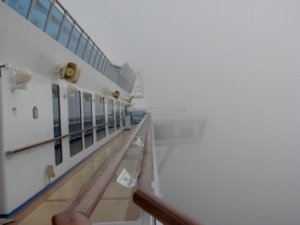
It is fairly common in shipping to sail into a zone which has minimal visibility for either weather changes, climate conditions or man-made factors such as intense fire causing thick smoke. This presents immediate danger for the ship and its crew as it increases chances of collision and later on, pollution.
While no one can alter weather conditions or predict them along with convincing polluting parties to refrain from their chosen disposal methods, one individual CAN avoid disasters due to limited visibility; the navigation officer. However, a navigation officer can vary in skills and experience which directly affects fates of the vessel in such conditions therefore it is essential to highlight the obligations which will help a vessel regardless of the officer’s skill.
To begin preparations, an officer who is informed about incoming conditions should take certain measures. Before such measures can be emplaced an officer should, prior to the voyage know the vessel from all angles and perspectives; technical and physical which establish a more solid, educated action plan that is more productive than guesswork which is as blind as the vessel is in such conditions. The benefits of such practice would teach the officer about the vessel’s behavior under different circumstances; especially in limited visibility where the factor of stopping distance, varying from vessel to vessel; increasing control over the vessel’s movement.
The next step is to notify the master who should also be notified about navigation conditions. Next, the OOW/Officer On Watch should inform the engine room and task the duty engineer to assume position in engine room in case the vessels goes to “unmanned mode.” The “unmanned” mode of a vessel is dangerous and occurs due to uneven spread of manpower; occurring due to poor management and errors in prioritisation and goal-set orientation. Some ship facilities such as the engine room is more important for movement while the bridge is important for navigation; the facilities that ALWAYS should have adequate manpower. However, another aspect of manpower is “lookouts;” personnel that keep watch on all the facilities of the vessel and report all errors.
The vessel occasionally, is not alone at sea as the sphere of maritime attracts more organisations which creates more traffic at sea; warranting special attention to the engine room in terms of manpower which the officer will command during requirement to maneuver. As much manpower as the engine room warrants, the speed of the vessel should be kept minimal and the fog horn should be ready; alongside navigation equipment and lights while keeping a radar watch and checking navigation charts.
Assuming that our vessel has adequate manpower distribution across the bridge and engine room alongside our navigation equipment being fully used to maneuver the seaspace without any collisions or error reports from the lookout personnel. However, though the ship is a network of different systems and requires most of them for efficient operation; it is essential to AVOID multitasking during limited visibility. All work that is not needed for the present situation should be stopped especially on-deck work which is likely to lead to injuries to on-deck crew if a collision should occur.
Sometimes, poor visibility is due to sandstorms and heavy rain; meaning that all openings from doors to ventilation should be closed at all times. Sand particles and rain flood can damage the ship’s equipment on entering the bridge. Finally, it is important to maintain channel 16 radio frequency while maintaining record of parameters such as longitude, latitude, speed, time and frequency in the log book.
Overall, navigating in limited visibility is challenging and dangerous; presenting chances for collision and serious damage. However, all can be avoided with proper observation and completion of procedures.

